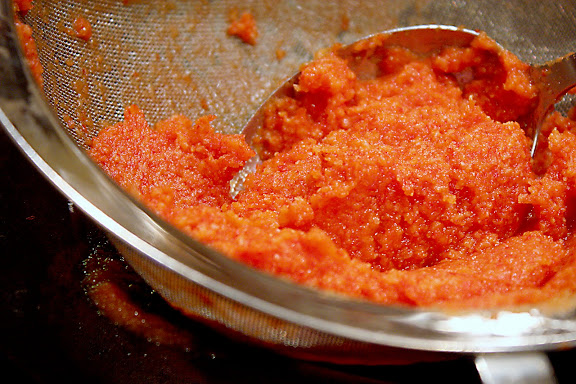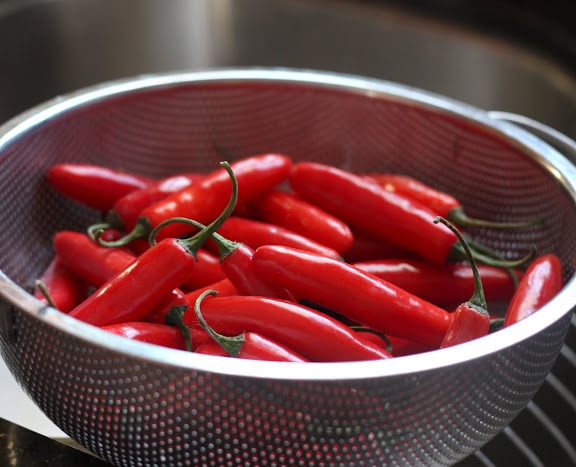
In continuing our Stock Your Thai Pantry series, one item that must be mentioned is Sriracha sauce (ซ้อสศรีราชา) — the all-purpose hot sauce that, according to the most prominent yet unsubstantiated theory, originated from a city after which it was named. I can’t think of any hot sauce that is more widely used and versatile when it comes to the modern Thai cuisine. Even though Sriracha has become a generic name for similar hot sauces made both domestically and outside of Thailand, the Thai palates don’t have a hard time recognizing the authentic spicy, sweet, tangy, garlicky sauce that we grew up with.
Folks seem a bit touchy when the subject of Sriracha (what’s authentic and what’s not, whether the name should be used to call non-Thai products, etc.) is brought up. So I will try my best to write this post in the most just-the-fact-ma’am way as I possibly can.
It has been suggested that Sriracha sauce is a sauce made according to a tradition begun in and around the city of Si Racha(อำเภอศรีราชา), a Thai eastern province of Chonburi(จังหวัดชลบุรี) — hence the name. But this has yet to be substantiated. Regardless, what we do know is that it is a sauce that originated from and has been heavily used in Thailand.
The sauce is traditionally made of fresh larger red peppers or พริกชี้ฟ้า (never dried peppers and usually not small bird’s eye ones or พริกขี้หนู), vinegar (white only — never rice or cider vinegar), garlic, sugar, and salt. It should also be noted that Sriracha sauce never contains tomatoes.1 Additionally, Sriracha always has smooth texture; it’s never chunky. When you look at it, you should not see pepper seeds or chunks of pepper skin. The sauce, as we know it in Thailand, does not have the texture of sambal — a sauce which, though delicious, should not be confused with Sriracha.
Thai Sriracha, according to my observation, is runnier and sweeter than the US-made Sriracha. The flavor lends itself very well to Thai dishes, especially those that can sometimes be a bit on the greasy side. (The heat and the tang help restore the balance.) I drizzle it on Thai omelet, turn it into a dipping sauce or a dipping sauce base, make a stir-fry sauce or marinade out of it, and use it as a barbecue sauce.
There are many other ways to use Thai Sriracha which I will mention here in future posts.
As an aside, to clear up the issue once and for all,the correct pronunciation of Sriracha, as recognized by literate native speakers of the Thai language, is see-rah-chah.2
Why make your own Sriracha? After all — not that I’ve ever conducted a nationwide poll — most Thai people don’t make their own Sriracha in much the same way as how Americans don’t normally make their own ketchup. But I, personally3, make my own Sriracha, because:
- I can. Anyone can.
- I want to. It’s kind of fun.
- I can adjust the seasoning to taste.
- I know exactly what goes into my food.
- It’s more economical.
- The flavor is bolder and fresher; the pepper and the garlic pack more punch.
- One 32-ounce batch lasts a long time. It can even be frozen.
- I have a killer recipe in my hand. (It comes from an unidentified source who does not wish that his name be made public.) Let’s just say, if the dominant brands in the US market, namely Shark and Sriraja Panich, had a love child, it would taste like this. For those who seek to replicate Huy Fong Sriracha, aka the rooster sauce, you’ll be disappointed by this recipe. This formula is for the kind of Sriracha sauce that we use in Thailand.
- 24 ounces (weight) fresh red jalapeño or serrano peppers, no substitute
- 8 ounces (weight) peeled garlic cloves
- 4 fluid ounces white vinegar
- 12 fluid ounces water
- 16 ounces (weight) granulated sugar
- 6 tablespoons salt (You can add more — up to 8 tablespoons — if it’s not salty enough, but it’s better to start with less.)
- Purée the first four ingredients together in a blender; strain the liquid into a heavy-bottomed pot, squeezing out as much liquid out of the pulp as you possibly can. It's important that you don't use a strainer with too fine mesh as you want to incorporate some pulp into the sauce. It's some of the fine pulp that passes through the strainer that gives the sauce body. If there's no pulp at all in the strained mixture, you'll end up with a hot, sweet, sticky syrup with may not taste so bad but it will lack the consistency of Thai Sriracha.
- Whisk the rest of the ingredients into the pepper-garlic purée and bring the mixture to a boil over medium heat, stirring occasionally.
- Reduce the heat and let the sauce simmer, uncovered, until the sauce is reduced down to about 4 cups and thickened up a bit, stirring occasionally. If you like your sauce less runny, reduce it longer; the recipe will yield less volume, but the sauce will be thicker and more intense.
- Let the sauce cool completely before storing in a glass jar. If you don’t stick a dirty spoon into the jar every time you use your sauce, your Sriracha will keep, refrigerated, for a month. It can also be frozen and thawed in the refrigerator.
- The sauce tastes best if left in the refrigerator for two days after it was made to allow the flavor to mellow out a bit. From that point on, the garlic isn’t quite so strong and the pepper isn’t quite so harsh and fiery.
1 Sriracha must not be confused with spicy tomato ketchup which is also commercially available in Thailand, though not nearly as popular or delicious, in my opinion.
2 Ignore the first R; it’s merely an unvocalized remnant of the original Sanskrit. All three syllables are open (CV) with clear breaks between them and must be pronounced in such a way that indicates these breaks (in other words, not SIR-otch-ah).
3 As opposed to impersonally? (Eyeroll)









79 Responses to Homemade Sriracha – How to Make Thai Sriracha ซ้อสศรีราชา